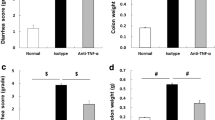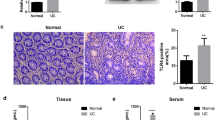Abstract
IL-17-producing Th17 cells and IFN-γ and IL-17 double-producing Th1/17 cells have been identified as the pathogenic cells in inflammatory bowel disease (IBD). Retinoic acid-related orphan receptor γt (RORγt) is a master regulator for the differentiation and activation of Th17 and Th1/17 cells. We discovered a novel orally available TAK-828F, a strong and selective RORγt inverse agonist. To assess the potential of RORγt blockade in the therapy for IBD, the efficacy of TAK-828F in activated T cell transfer mouse colitis model was investigated. This model was highly sensitive to the prophylactic treatment of anti-TNF-α monoclonal antibody but partially susceptible to sulfasalazine, tacrolimus, and prednisolone. Oral administration of TAK-828F, at doses of 1 and 3 mg/kg, b.i.d, strongly protected the progression of colitis. TAK-828F decreased the population of Th17 and Th1/17 cells in a dose-dependent manner in the mesenteric lymph node. Moreover, expression of mRNA that are characteristic of the Th17 signature, such as IL-17A and IL-17F in the colon, were inhibited by TAK-828F, while the expression of IL-10, an anti-inflammatory cytokine, was increased. In the therapeutic treatment, TAK-828F lessened disease severity compared to the vehicle control mice. Interestingly, gene expression of zonula occludens-1 (ZO-1) and mucin 2 (Muc2), which play an important role in barrier function of the intestinal mucosa, was recovered by TAK-828F. These results indicate that blocking RORγt has promising pharmacological profile in the colitis model. RORγt blockade may provide a novel therapeutic paradigm for treatment of IBD with unique mechanism by which improves imbalance of the immune system.





Similar content being viewed by others
References
Allen, A., D.A. Hutton, and J.P. Pearson. 1998. The MUC2 gene product: a human intestinal mucin. The International Journal of Biochemistry & Cell Biology 30 (7): 797–801.
Fauber, B.P., O. Rene, Y. Deng, J. DeVoss, C. Eidenschenk, C. Everett, A. Ganguli, et al. 2015. Discovery of 1-{4-[3-fluoro-4-((3s,6r)-3-methyl-1,1-dioxo-6-phenyl-[1,2]thiazinan-2-ylmethyl)- phenyl]-piperazin-1-yl}-ethanone (GNE-3500): a potent, selective, and orally bioavailable retinoic acid receptor-related orphan receptor C (RORc or RORgamma) inverse agonist. Journal of Medicinal Chemistry 58 (13): 5308–5322. https://doi.org/10.1021/acs.jmedchem.5b00597.
Feagan, Brian G., William J. Sandborn, Geert D'Haens, Julián Panés, Arthur Kaser, Marc Ferrante, Edouard Louis, Denis Franchimont, Olivier Dewit, Ursula Seidler, Kyung-Jo Kim, Markus F. Neurath, Stefan Schreiber, Paul Scholl, Chandrasena Pamulapati, Bojan Lalovic, Sudha Visvanathan, Steven J. Padula, Ivona Herichova, Adina Soaita, David B. Hall, and Wulf O. Böcher. 2017. Induction therapy with the selective interleukin-23 inhibitor risankizumab in patients with moderate-to-severe Crohn's disease: a randomised, double-blind, placebo-controlled phase 2 study. The Lancet 389 (10080): 1699–1709. https://doi.org/10.1016/s0140-6736(17)30570-6.
Fuss, I.J., M. Neurath, M. Boirivant, J.S. Klein, C. de la Motte, S.A. Strong, C. Fiocchi, and W. Strober. 1996. Disparate CD4+ lamina propria (LP) lymphokine secretion profiles in inflammatory bowel disease. Crohn's disease LP cells manifest increased secretion of IFN-gamma, whereas ulcerative colitis LP cells manifest increased secretion of IL-5. Journal of Immunology 157 (3): 1261–1270.
Galvez, J. 2014. Role of Th17 Cells in the Pathogenesis of Human IBD. ISRN Inflamm 2014: 928461–928414. https://doi.org/10.1155/2014/928461.
Gerner, R.R., A.R. Moschen, and H. Tilg. 2013. Targeting T and B lymphocytes in inflammatory bowel diseases: lessons from clinical trials. Digestive Diseases 31 (3–4): 328–335. https://doi.org/10.1159/000354687.
Globig, A.M., N. Hennecke, B. Martin, M. Seidl, G. Ruf, P. Hasselblatt, R. Thimme, and B. Bengsch. 2014. Comprehensive intestinal T helper cell profiling reveals specific accumulation of IFN-gamma+IL-17+coproducing CD4+ T cells in active inflammatory bowel disease. Inflammatory Bowel Diseases 20 (12): 2321–2329. https://doi.org/10.1097/MIB.0000000000000210.
Gregori, S., K.S. Goudy, and M.G. Roncarolo. 2012. The cellular and molecular mechanisms of immuno-suppression by human type 1 regulatory T cells. Frontiers in Immunology 3: 30. https://doi.org/10.3389/fimmu.2012.00030.
Groux, H., A. O'Garra, M. Bigler, M. Rouleau, S. Antonenko, J.E. de Vries, and M.G. Roncarolo. 1997. A CD4+ T-cell subset inhibits antigen-specific T-cell responses and prevents colitis. Nature 389 (6652): 737–742. https://doi.org/10.1038/39614.
Guo, Y., G. Zhou, C. He, W. Yang, Z. He, and Z. Liu. 2015. Serum Levels of Lipopolysaccharide and 1,3-beta-D-Glucan Refer to the Severity in Patients with Crohn’s Disease. Mediators of Inflammation 2015: 843089–843089. https://doi.org/10.1155/2015/843089.
Hanauer, S.B. 2010. The expanding role of biologic therapy for IBD. Nature Reviews. Gastroenterology & Hepatology 7 (2): 63–64. https://doi.org/10.1038/nrgastro.2009.238.
Harbour, S.N., C.L. Maynard, C.L. Zindl, T.R. Schoeb, and C.T. Weaver. 2015. Th17 cells give rise to Th1 cells that are required for the pathogenesis of colitis. Proceedings of the National Academy of Sciences of the United States of America 112 (22): 7061–7066. https://doi.org/10.1073/pnas.1415675112.
Huh, J.R., and D.R. Littman. 2012. Small molecule inhibitors of RORgammat: targeting Th17 cells and other applications. European Journal of Immunology 42 (9): 2232–2237. https://doi.org/10.1002/eji.201242740.
Igaki, K., Y. Komoike, Y. Nakamura, T. Watanabe, M. Yamasaki, P. Fleming, L. Yang, D. Soler, E. Fedyk, and N. Tsuchimori. 2018. MLN3126, an antagonist of the chemokine receptor CCR9, ameliorates inflammation in a T cell mediated mouse colitis model. International Immunopharmacology 60: 160–169. https://doi.org/10.1016/j.intimp.2018.04.049.
Ivanov, I.I., B.S. McKenzie, L. Zhou, C.E. Tadokoro, A. Lepelley, J.J. Lafaille, D.J. Cua, and D.R. Littman. 2006. The orphan nuclear receptor RORgammat directs the differentiation program of proinflammatory IL-17+ T helper cells. Cell 126 (6): 1121–1133. https://doi.org/10.1016/j.cell.2006.07.035.
Jiang, W., J. Su, X. Zhang, X. Cheng, J. Zhou, R. Shi, and H. Zhang. 2014. Elevated levels of Th17 cells and Th17-related cytokines are associated with disease activity in patients with inflammatory bowel disease. Inflammation Research 63 (11): 943–950. https://doi.org/10.1007/s00011-014-0768-7.
Kaplan, G.G. 2015. The global burden of IBD: from 2015 to 2025. Nature Reviews. Gastroenterology & Hepatology 12 (12): 720–727. https://doi.org/10.1038/nrgastro.2015.150.
Kebir, H., I. Ifergan, J.I. Alvarez, M. Bernard, J. Poirier, N. Arbour, P. Duquette, and A. Prat. 2009. Preferential recruitment of interferon-gamma-expressing TH17 cells in multiple sclerosis. Annals of Neurology 66 (3): 390–402. https://doi.org/10.1002/ana.21748.
Khanna, R., J.C. Preiss, J.K. MacDonald, and A. Timmer. 2015. Anti-IL-12/23p40 antibodies for induction of remission in Crohn’s disease. Cochrane Database of Systematic Reviews 5: CD007572. https://doi.org/10.1002/14651858.CD007572.pub2.
Kono, M., A. Ochida, T. Oda, T. Imada, Y. Banno, N. Taya, S. Masada, T. Kawamoto, K. Yonemori, Y. Nara, Y. Fukase, T. Yukawa, H. Tokuhara, R. Skene, B.C. Sang, I.D. Hoffman, G.P. Snell, K. Uga, A. Shibata, K. Igaki, Y. Nakamura, H. Nakagawa, N. Tsuchimori, M. Yamasaki, J. Shirai, and S. Yamamoto. 2018. Discovery of [cis-3-({(5 R)-5-[(7-Fluoro-1,1-dimethyl-2,3-dihydro-1 H-inden-5-yl)carbamoyl]-2-methoxy-7,8-dihydro-1,6-naphthyridin-6(5 H)-yl}carbonyl)cyclobutyl] acetic Acid (TAK-828F) as a Potent, Selective, and Orally Available Novel Retinoic Acid Receptor-Related Orphan Receptor gammat Inverse Agonist. Journal of Medicinal Chemistry 61 (7): 2973–2988. https://doi.org/10.1021/acs.jmedchem.8b00061.
Lee, S.H. 2015. Intestinal permeability regulation by tight junction: implication on inflammatory bowel diseases. Intest Res 13 (1): 11–18. https://doi.org/10.5217/ir.2015.13.1.11.
Lee, Y.K., H. Turner, C.L. Maynard, J.R. Oliver, D. Chen, C.O. Elson, and C.T. Weaver. 2009. Late developmental plasticity in the T helper 17 lineage. Immunity 30 (1): 92–107. https://doi.org/10.1016/j.immuni.2008.11.005.
Leppkes, M., C. Becker, I.I. Ivanov, S. Hirth, S. Wirtz, C. Neufert, S. Pouly, A.J. Murphy, D.M. Valenzuela, G.D. Yancopoulos, B. Becher, D.R. Littman, and M.F. Neurath. 2009. RORgamma-expressing Th17 cells induce murine chronic intestinal inflammation via redundant effects of IL-17A and IL-17F. Gastroenterology 136 (1): 257–267. https://doi.org/10.1053/j.gastro.2008.10.018.
M'Koma, A.E. 2013. Inflammatory bowel disease: an expanding global health problem. Clin Med Insights Gastroenterol 6: 33–47. https://doi.org/10.4137/CGast.S12731.
Martin, B., K. Hirota, D.J. Cua, B. Stockinger, and M. Veldhoen. 2009. Interleukin-17-producing gammadelta T cells selectively expand in response to pathogen products and environmental signals. Immunity 31 (2): 321–330. https://doi.org/10.1016/j.immuni.2009.06.020.
Morishima, N., I. Mizoguchi, K. Takeda, J. Mizuguchi, and T. Yoshimoto. 2009. TGF-beta is necessary for induction of IL-23R and Th17 differentiation by IL-6 and IL-23. Biochemical and Biophysical Research Communications 386 (1): 105–110. https://doi.org/10.1016/j.bbrc.2009.05.140.
Muir, R., M. Osbourn, A.V. Dubois, E. Doran, D.M. Small, A. Monahan, C.M. O'Kane, et al. 2016. Innate Lymphoid Cells Are the Predominant Source of IL-17A during the Early Pathogenesis of Acute Respiratory Distress Syndrome. American Journal of Respiratory and Critical Care Medicine 193 (4): 407–416. https://doi.org/10.1164/rccm.201410-1782OC.
Nakagawa, H., Koyama, R., Kamada, Y., Ochida, A., Kono, M., Shirai, J., Yamamoto, S et al. 2018. Biochemical properties of. TAK-828F, a potent and selective RORγt inverse agonist. Pharmacology. (in press).
Parronchi, P., P. Romagnani, F. Annunziato, S. Sampognaro, A. Becchio, L. Giannarini, E. Maggi, C. Pupilli, F. Tonelli, and S. Romagnani. 1997. Type 1 T-helper cell predominance and interleukin-12 expression in the gut of patients with Crohn’s disease. The American Journal of Pathology 150 (3): 823–832.
Quintana, F.J., A.S. Basso, A.H. Iglesias, T. Korn, M.F. Farez, E. Bettelli, M. Caccamo, M. Oukka, and H.L. Weiner. 2008. Control of T (reg) and T (H)17 cell differentiation by the aryl hydrocarbon receptor. Nature 453 (7191): 65–71. https://doi.org/10.1038/nature06880.
Rachitskaya, A.V., A.M. Hansen, R. Horai, Z. Li, R. Villasmil, D. Luger, R.B. Nussenblatt, and R.R. Caspi. 2008. Cutting Edge: NKT Cells Constitutively Express IL-23 Receptor and ROR t and Rapidly Produce IL-17 upon Receptor Ligation in an IL-6-Independent Fashion. The Journal of Immunology 180 (8): 5167–5171. https://doi.org/10.4049/jimmunol.180.8.5167.
Rovedatti, L., T. Kudo, P. Biancheri, M. Sarra, C.H. Knowles, D.S. Rampton, G.R. Corazza, G. Monteleone, A. Di Sabatino, and T.T. Macdonald. 2009. Differential regulation of interleukin 17 and interferon gamma production in inflammatory bowel disease. Gut 58 (12): 1629–1636. https://doi.org/10.1136/gut.2009.182170.
Shibata, A., K. Uga, T. Sato, M. Sagara, K. Igaki, Y. Nakamura, A. Ochida, M. Kono, J. Shirai, S. Yamamoto, M. Yamasaki, and N. Tsuchimori. 2018. Pharmacological inhibitory profile of TAK-828F, a potent and selective orally available RORgammat inverse agonist. Biochemical Pharmacology 150: 35–45. https://doi.org/10.1016/j.bcp.2018.01.023.
Shimizu, J., K. Takai, N. Fujiwara, N. Arimitsu, Y. Ueda, S. Wakisaka, H. Yoshikawa, F. Kaneko, T. Suzuki, and N. Suzuki. 2012. Excessive CD4+ T cells co-expressing interleukin-17 and interferon-gamma in patients with Behcet’s disease. Clinical and Experimental Immunology 168 (1): 68–74. https://doi.org/10.1111/j.1365-2249.2011.04543.x.
Skepner, J., R. Ramesh, M. Trocha, D. Schmidt, E. Baloglu, M. Lobera, T. Carlson, J. Hill, L.A. Orband-Miller, A. Barnes, M. Boudjelal, M. Sundrud, S. Ghosh, and J. Yang. 2014. Pharmacologic inhibition of RORgammat regulates Th17 signature gene expression and suppresses cutaneous inflammation in vivo. Journal of Immunology 192 (6): 2564–2575. https://doi.org/10.4049/jimmunol.1302190.
Sujino, T., T. Kanai, Y. Ono, Y. Mikami, A. Hayashi, T. Doi, K. Matsuoka, T. Hisamatsu, H. Takaishi, H. Ogata, A. Yoshimura, D.R. Littman, and T. Hibi. 2011. Regulatory T cells suppress development of colitis, blocking differentiation of T-helper 17 into alternative T-helper 1 cells. Gastroenterology 141 (3): 1014–1023. https://doi.org/10.1053/j.gastro.2011.05.052.
Withers, D.R., M.R. Hepworth, X. Wang, E.C. Mackley, E.E. Halford, E.E. Dutton, C.L. Marriott, V. Brucklacher-Waldert, M. Veldhoen, J. Kelsen, R.N. Baldassano, and G.F. Sonnenberg. 2016. Transient inhibition of ROR-gammat therapeutically limits intestinal inflammation by reducing TH17 cells and preserving group 3 innate lymphoid cells. Nature Medicine 22 (3): 319–323. https://doi.org/10.1038/nm.4046.
Xiao, S., N. Yosef, J. Yang, Y. Wang, L. Zhou, C. Zhu, C. Wu, E. Baloglu, D. Schmidt, R. Ramesh, M. Lobera, M.S. Sundrud, P.Y. Tsai, Z. Xiang, J. Wang, Y. Xu, X. Lin, K. Kretschmer, P.B. Rahl, R.A. Young, Z. Zhong, D.A. Hafler, A. Regev, S. Ghosh, A. Marson, and V.K. Kuchroo. 2014. Small-molecule RORgammat antagonists inhibit T helper 17 cell transcriptional network by divergent mechanisms. Immunity 40 (4): 477–489. https://doi.org/10.1016/j.immuni.2014.04.004.
Zhu, J., and W.E. Paul. 2008. CD4 T cells: fates, functions, and faults. Blood 112 (5): 1557–1569. https://doi.org/10.1182/blood-2008-05-078154.
Acknowledgments
The authors thank the following employees of Takeda Pharmaceutical Company Ltd.: Yasushi Fujitani, Chihiro Akimoto, Keiko Koga and Keiko Ishigami, and Hikaru Saitou for their contribution to pharmacological studies and discussion and Tsuneo Oda, Atsuko Ochida, Mitsunori Kono, Junya Shirai, and Satoshi Yamamoto for their contribution to compound synthesis.
Author information
Authors and Affiliations
Corresponding author
Ethics declarations
Conflict of Interest
The authors declare that they have no conflict of interest.
Rights and permissions
About this article
Cite this article
Igaki, K., Nakamura, Y., Komoike, Y. et al. Pharmacological Evaluation of TAK-828F, a Novel Orally Available RORγt Inverse Agonist, on Murine Colitis Model. Inflammation 42, 91–102 (2019). https://doi.org/10.1007/s10753-018-0875-7
Published:
Issue Date:
DOI: https://doi.org/10.1007/s10753-018-0875-7




